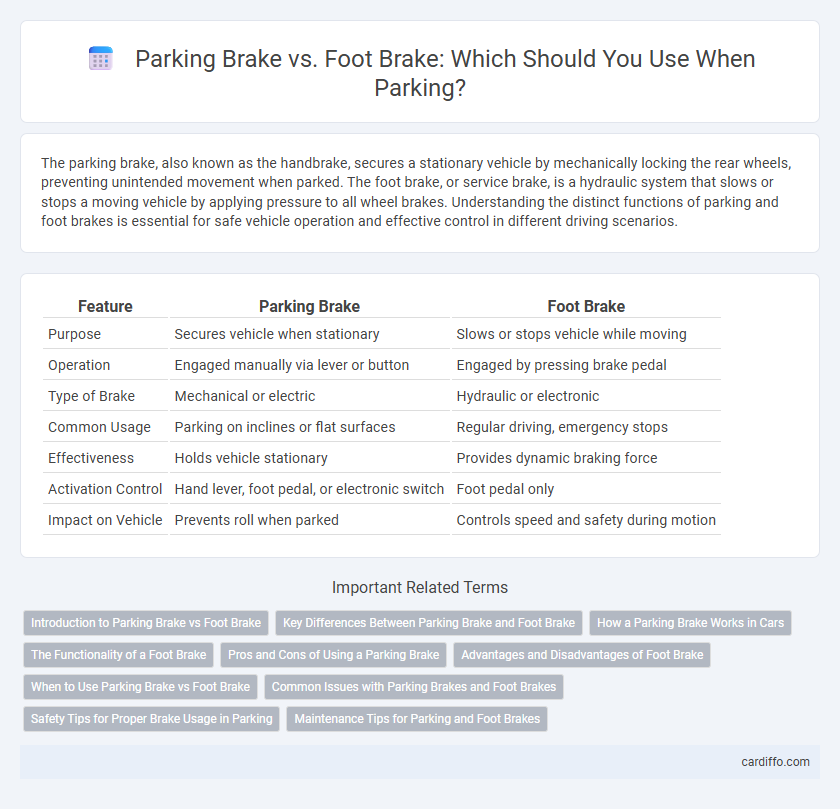The parking brake, also known as the handbrake, secures a stationary vehicle by mechanically locking the rear wheels, preventing unintended movement when parked. The foot brake, or service brake, is a hydraulic system that slows or stops a moving vehicle by applying pressure to all wheel brakes. Understanding the distinct functions of parking and foot brakes is essential for safe vehicle operation and effective control in different driving scenarios.
Table of Comparison
| Feature | Parking Brake | Foot Brake |
|---|---|---|
| Purpose | Secures vehicle when stationary | Slows or stops vehicle while moving |
| Operation | Engaged manually via lever or button | Engaged by pressing brake pedal |
| Type of Brake | Mechanical or electric | Hydraulic or electronic |
| Common Usage | Parking on inclines or flat surfaces | Regular driving, emergency stops |
| Effectiveness | Holds vehicle stationary | Provides dynamic braking force |
| Activation Control | Hand lever, foot pedal, or electronic switch | Foot pedal only |
| Impact on Vehicle | Prevents roll when parked | Controls speed and safety during motion |
Introduction to Parking Brake vs Foot Brake
The parking brake, also known as the emergency brake, is designed to hold a vehicle stationary when parked, typically operating mechanically through a lever or pedal that engages the rear brakes. In contrast, the foot brake, commonly referred to as the service brake, is hydraulically operated and used to slow down or stop the vehicle while driving. Understanding the functional differences between the parking brake and foot brake ensures proper vehicle control and safety during both parking and driving conditions.
Key Differences Between Parking Brake and Foot Brake
The parking brake, also known as the hand or emergency brake, is designed to keep a vehicle stationary when parked by mechanically locking the rear wheels, while the foot brake, or service brake, controls the vehicle's motion by hydraulically applying pressure to all four wheels to slow down or stop while driving. The parking brake operates independently of the main braking system and is typically engaged manually, whereas the foot brake is activated by the driver's foot and is essential for normal driving and emergency stops. Key differences include their operational purpose, method of engagement, and the type of braking force applied--mechanical for parking brakes and hydraulic for foot brakes.
How a Parking Brake Works in Cars
The parking brake, also known as the handbrake or emergency brake, works by mechanically locking the rear wheels through a cable system connected to brake shoes or pads. When engaged, it prevents the vehicle from rolling by maintaining tension in the cable, which applies force directly to the braking components, independent of the hydraulic system used by the foot brake. This mechanism ensures the car remains stationary on inclines or when parked, providing an essential safety function separate from the primary foot brake.
The Functionality of a Foot Brake
The foot brake, also known as the service brake, is primarily responsible for slowing down or stopping a vehicle during normal driving conditions by applying hydraulic pressure to the brake pads or shoes. Its functionality involves activating the disc or drum brakes on all wheels, ensuring controlled deceleration and vehicle stability. Unlike the parking brake, which secures a stationary vehicle, the foot brake is essential for dynamic control and emergency stopping.
Pros and Cons of Using a Parking Brake
The parking brake, also known as the emergency brake, provides a reliable method to secure a vehicle when parked, especially on inclined surfaces, preventing unintended rolling. Unlike the foot brake, which is hydraulic and designed for stopping a moving vehicle, the parking brake operates mechanically, offering a backup in case of primary brake failure. However, frequent use of the parking brake may lead to cable wear or sticking, and it is less effective if not regularly maintained.
Advantages and Disadvantages of Foot Brake
The foot brake offers precise control and power for stopping a vehicle quickly, making it essential for everyday driving and emergencies. Its disadvantages include potential wear and tear from frequent use, and it cannot hold a vehicle stationary on steep inclines without risking slippage. Unlike the parking brake, the foot brake does not provide a secure, long-term hold when a vehicle is parked.
When to Use Parking Brake vs Foot Brake
Use the parking brake primarily when the vehicle is stationary to prevent it from rolling, especially on inclines or uneven surfaces. The foot brake is essential for slowing down or stopping the vehicle while in motion, providing immediate control during driving. Applying the parking brake after using the foot brake ensures the vehicle remains securely in place when parked.
Common Issues with Parking Brakes and Foot Brakes
Common issues with parking brakes include cable corrosion, reduced tension, and brake pad wear, leading to ineffective holding power and potential vehicle rollaways. Foot brakes often face problems such as brake fluid leaks, worn brake pads, and air in the brake lines, resulting in decreased stopping performance and spongy pedal feel. Regular maintenance and inspection of both systems are essential to ensure optimal braking safety and functionality.
Safety Tips for Proper Brake Usage in Parking
Engaging the parking brake firmly ensures vehicle stability on inclines and prevents unintended movement, enhancing overall safety during parking. When parking on a slope, always apply the foot brake first to hold the vehicle and then engage the parking brake to secure it fully. Regular maintenance checks of both parking and foot brakes are crucial to guarantee responsiveness and prevent brake failure.
Maintenance Tips for Parking and Foot Brakes
Regular inspection of parking brakes and foot brakes is essential to ensure safety and optimal performance, with attention to cable tension, brake pad thickness, and fluid levels. Lubricate moving parts and adjust cables periodically to prevent stiffness and ensure responsive braking. Replace worn brake pads or shoes promptly and bleed brake lines to maintain effective hydraulic pressure in foot brakes.
Parking Brake vs Foot Brake Infographic

 cardiffo.com
cardiffo.com